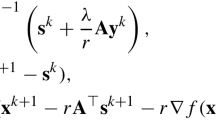Abstract
The general discrete-time Single-Input Single-Output (SISO) mixed H 2/l 1 control problem is considered in this paper. It is found that the existing results of duality theory cannot be directly applied to this infinite dimension optimisation problem. By means of two finite dimension approximate problems, to which duality theory can be applied, the dual of the mixed H 2/l 1 control problem is verified to be the limit of the duals of these two approximate problems.
Similar content being viewed by others
References
B. A. Francis. A Course in H ∞ Control Theory, Springer-Verlag, Berlin, 1987.
G. Zames. Feedback and optimal sensitivity: model reference transformations, multiplicative seminorms and approximate inverses. IEEE Transactions on Automatic Control, vol. 26, no. 2, pp. 301–320, 1981.
D. C. Youla, H. A. Jabr, J. J. Bongiorno. Modern Wiener-Hopf design of optimal controllers-part II: the multivariable case. IEEE Transactions on Automatic Control, vol. AC-21, no. 3, pp. 319–338, 1976.
M. Vidyasagar, Optimal rejection of persistent bounded disturbances. IEEE Transactions on Automatic Control, vol. 31, no. 6, pp. 527–534, 1986.
I. Kaminer, P. P. Khargonekar, M. A. Rotea. Mixed H 2/H ∞ control for discrete time systems via convex optimization. Automatica, vol. 29, no. 1, pp. 57–70, 1993.
M. Sznaier, J. Bu. On the properties of the solutions to mixed l 1/H ∞ control problems, In Preprints 13th IFAC Congress, San Francisco, USA, vol. G, pp. 249–254, 1996.
M. V. Salapaka, M. Dahleh, P. Voulgaris. Mixed objective control synthesis: optimal l 1/H 2 control. SIAM Journal of Control and Optimization, vol. 35, no. 5, pp. 1672–1689, 1997.
P. Voulgaris. Optimal H 2/l 1 control: the SISO case. In Proceedings of IEEE International Conference on Decision and Control, vol. 4, pp. 3181–3186, 1994.
P. Voulgaris. Optimal H 2/l 1 control via duality theory. IEEE Transaction on Automatic Control, vol. 40, pp. 1881–1888, 1995.
J. Wu, J. Chu. Mixed H 2/l 1 control for discrete time systems. In Preprints 13th IFAC Congress, San Francisco, USA, vol. G, pp. 453–457, 1996.
J. Wu, J. Chu. Approximation methods of scalar mixed H 2/l 1 problems for discrete-time systems. IEEE Transactions on Automatic Control, vol. 44, no. 10, pp. 1869–1874, 1999.
M. V. Salapaka, M. Khammash, M. Dahleh. Solution of MIMO H 2/l 1 problem without zero interpolation. SIAM Journal of Control and Optimization, vol. 37, no. 6, 1865–1873, 1999.
N. Elia, M. A. Dahleh. Control design with multiple objectives. IEEE Transactions on Automatic Control, vol. 42, no. 5, pp. 596–613, 1997.
M. V. Salapaka, M. Dahleh, P. G. Voulgaris. MIMO optimal control design: the interplay between the H 2 and the l 1 norms. IEEE Transactions on Automatic Control, vol. 43, no. 10, pp. 1374–1388, 1998.
J. Brinkhuis. Introduction to duality in optimization theory. Journal of Optimization Theory and Applications, vol. 91, pp. 523–542, 1996.
D. G. Luenberger. Optimization by Vector Space Methods, Wiley, New York, 1969.
Author information
Authors and Affiliations
Corresponding author
Additional information
This work is supported by the National Natural Science Foundation of China (No.60374002 and No.60421002), the 973 program of China (No.2002CB312200), and the program for New Century Excellent Talents in University (No.NCET-04-0547).
Jun Wu received the BEng and PhD degrees both in industrial automation from Huazhong University of Science and Technology, China in 1989 and 1994, respectively. Since 1994, he has been a faculty member at the Institute of Advanced Process Control, Zhejiang University, China, where he is currently a Professor. Dr Wu’s recent research work includes, finite-precision digital controller design, networked control, model reduction, and robust control and optimization. He has published over 50 papers in journals and conference proceedings, and was awarded a 1997/1998 IEE Heaviside Premium.
Sheng Chen obtained a BEng degree in control engineering from the East China Petroleum Institute, Dongying, China, in 1982, and a PhD degree in control engineering from City University, London, UK, in 1986. He joined the School of Electronics and Computer Science at the University of Southampton, UK, in September 1999. He previously held research and academic appointments at the Universities of Sheffield, Edinburgh, and Portsmouth, all in the UK. Professor Chen, holds a higher doctorate degree, DSc, from the University of Southampton. His recent research work includes adaptive nonlinear signal processing, wireless communications, modelling and identification of nonlinear systems, neural network and machine learning, finite-precision digital controller design, and evolutionary computation methods and optimization. He has published over 240 research papers. In the database of the world’s most highly cited researchers in various disciplines, compiled by the Institute for Scientific Information (ISI) of the USA, Dr Chen is on the list of highly cited researchers in the engineering category, see www.ISIHighlyCited.com.
Jian Chu received BEng and MSc degrees both in industrial automation from Zhejiang University, China, in 1982 and 1984 respectively. As a PhD candidate of the joint education programme between Zhejiang University and Kyoto University Japan, he received a PhD degree in industrial automation from Zhejiang University in 1989. Since 1989, he has been a faculty member at the Institute of Advanced Process Control, Zhejiang University, where he currently is the Institute Director, and is a Professor of the Cheung Kong Scholars Programme. He is also the Director of the National Laboratory of Industrial Control Technology, and a Deputy Director of the National Engineering Research Center for Industrial Automation. His research areas include advanced process control, robust control, and fieldbus control systems. He has published over 300 papers in journals and conference proceedings, and was awarded a 1997/1998 IEE Heaviside Premium.
Rights and permissions
About this article
Cite this article
Wu, J., Chu, J. & Chen, S. On the dual of a mixed H 2/l 1 optimisation problem. Int J Automat Comput 3, 91–98 (2006). https://doi.org/10.1007/s11633-006-0091-z
Received:
Revised:
Issue Date:
DOI: https://doi.org/10.1007/s11633-006-0091-z




